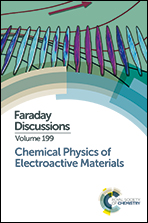Strain–capacitance relationship in polymer actuators based on single-walled carbon nanotubes and ionic liquid gels†
Abstract
We investigate the electromechanical properties of bucky-gel electrochemical actuators incorporating various amounts of single-walled carbon nanotubes and an ionic liquid electrolyte, 1-butyl-3-methylimidazolium tetrafluoroborate, that are able to convert electrochemical energy into mechanical energy. The interplay between mechanical and electrochemical effects is studied. The electromechanical responses are investigated by means of electrochemical impedance spectroscopy and bending displacement measurements. We develop a theoretical model that allows us to rationalize the electromechanical properties of the bucky-gel actuators. This model takes into account electrochemical stress due to the intercalation (de-intercalation) process, which generates the strain and bending of the actuators. We then analyze the relationship between the strain and the real part of the complex capacitance by introducing a strain–capacitance coefficient. This coefficient is related to the electrochemical stress and the amount of the ionic adsorption (desorption) at the double-layer. From a practical point of view, the determination of the strain–capacitance coefficient is helpful for characterizing and optimizing the performance of electrochemical actuators.
- This article is part of the themed collection: Chemical Physics of Electroactive Materials

 Please wait while we load your content...
Please wait while we load your content...